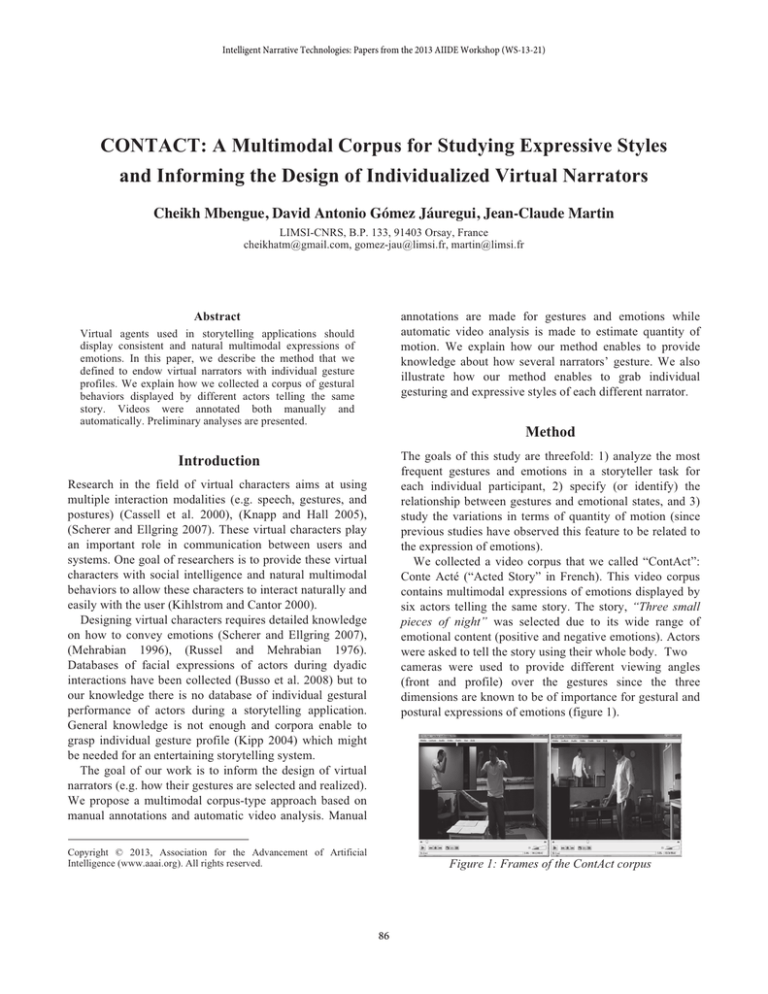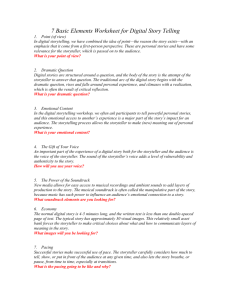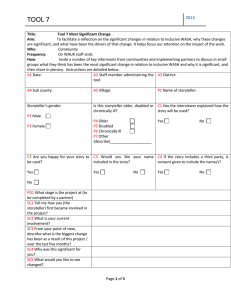
Intelligent Narrative Technologies: Papers from the 2013 AIIDE Workshop (WS-13-21)
CONTACT: A Multimodal Corpus for Studying Expressive Styles
and Informing the Design of Individualized Virtual Narrators
Cheikh Mbengue, David Antonio Gómez Jáuregui, Jean-Claude Martin
LIMSI-CNRS, B.P. 133, 91403 Orsay, France
cheikhatm@gmail.com, gomez-jau@limsi.fr, martin@limsi.fr
annotations are made for gestures and emotions while
automatic video analysis is made to estimate quantity of
motion. We explain how our method enables to provide
knowledge about how several narrators’ gesture. We also
illustrate how our method enables to grab individual
gesturing and expressive styles of each different narrator.
Abstract
Virtual agents used in storytelling applications should
display consistent and natural multimodal expressions of
emotions. In this paper, we describe the method that we
defined to endow virtual narrators with individual gesture
profiles. We explain how we collected a corpus of gestural
behaviors displayed by different actors telling the same
story. Videos were annotated both manually and
automatically. Preliminary analyses are presented.
Method
The goals of this study are threefold: 1) analyze the most
frequent gestures and emotions in a storyteller task for
each individual participant, 2) specify (or identify) the
relationship between gestures and emotional states, and 3)
study the variations in terms of quantity of motion (since
previous studies have observed this feature to be related to
the expression of emotions).
We collected a video corpus that we called “ContAct”:
Conte Acté (“Acted Story” in French). This video corpus
contains multimodal expressions of emotions displayed by
six actors telling the same story. The story, “Three small
pieces of night” was selected due to its wide range of
emotional content (positive and negative emotions). Actors
were asked to tell the story using their whole body. Two
cameras were used to provide different viewing angles
(front and profile) over the gestures since the three
dimensions are known to be of importance for gestural and
postural expressions of emotions (figure 1).
Introduction
Research in the field of virtual characters aims at using
multiple interaction modalities (e.g. speech, gestures, and
postures) (Cassell et al. 2000), (Knapp and Hall 2005),
(Scherer and Ellgring 2007). These virtual characters play
an important role in communication between users and
systems. One goal of researchers is to provide these virtual
characters with social intelligence and natural multimodal
behaviors to allow these characters to interact naturally and
easily with the user (Kihlstrom and Cantor 2000).
Designing virtual characters requires detailed knowledge
on how to convey emotions (Scherer and Ellgring 2007),
(Mehrabian 1996), (Russel and Mehrabian 1976).
Databases of facial expressions of actors during dyadic
interactions have been collected (Busso et al. 2008) but to
our knowledge there is no database of individual gestural
performance of actors during a storytelling application.
General knowledge is not enough and corpora enable to
grasp individual gesture profile (Kipp 2004) which might
be needed for an entertaining storytelling system.
The goal of our work is to inform the design of virtual
narrators (e.g. how their gestures are selected and realized).
We propose a multimodal corpus-type approach based on
manual annotations and automatic video analysis. Manual
Copyright © 2013, Association for the Advancement of Artificial
Intelligence (www.aaai.org). All rights reserved.
Figure 1: Frames of the ContAct corpus
86
The frequency of emotional categories was analyzed for
the entire video corpus. According to results, the most
frequent emotional category presented for the task is
+P+A-D (55.12%), followed by -P-A+D (18.65%), P+A+D (12.10%), -P+A-D (10.92%), -P-A-D (1.34%),
+P+A+D (1.18%), +P-A+D (0.33%) and +P-A-D (0%).
We analyzed the frequency of each gesture regarding the
most frequent emotion (+P +A-D). Emblem gestures
represent almost half (47.9%) of the total of gestures for
this emotion (+P +A -D), followed by Beat (20.5%),
Metaphoric (16.4%), Deictic (8.89%) and Iconic (7.3%).
The average of the quantity of motion was calculated for
each video sequence (storyteller) with respect to
handedness, gesture category, and emotion. We computed
a two-way ANOVA analysis design for each group of two
factors (use of Hands x Storytellers, Gestural Categories x
Storytellers, Emotion x Storytellers). The response
measure was the average of the quantity of motion.
The quantity of motion measure was entered into a twoway factor (Use of hands x Storyteller) ANOVA analysis.
For the use of hands factor, the independent variables
were: Two Hands (2H), Right Hand (RH) and Left Hand
(LH). For the Storyteller factor, the independent variables
were: Storyteller 1 (S1), Storyteller 2 (S2), Storyteller 3
(S3), Storyteller 4 (S4), Storyteller 5 (S5), and Storyteller 6
(S6). The dependent variable was the quantity of motion.
In order to annotate gestures, we used the following
steps (Kipp 2004):
1. Gesture segmentation. Each video was segmented
in different time intervals which contain a specific
gesture (gesture phase).
2. Handedness. The use of hands was annotated for
each gesture (left hand, right hand or both hands).
3. Gesture category. Each gesture was identified as
one of the five gestural categories (Kipp 2004).
The emotional categories were annotated by segmenting
each video with respect to the different sentences spoken
by the actors. For each sentence, the emotion was
annotated by giving a value from High, Medium and Low
to each of the three main dimensions of emotions
(pleasure, activation and dominance). By combining these
three variables, we obtain a category of emotion selected
from the following list (Mehrabian 1996), (Kipp and
Martin 2009), for example: Exuberant, admired, bold,
excited (+P +A +D).
The validation of annotations was made with the
calculation of Kappa (Carletta 1996). Two observers
validated the manual annotation of use of hands and
gestures. The inter-rater reliability for the use of hands
was found to be Kappa = 0.83 and for the gestures was
Kappa = 0.59. For the moment, the emotional categories
have been validated by one observer, as future perspective
the annotations will be made by several observers and a
measure of inter-coder agreement.
The quantity of motion for each frame was automatically
extracted using computer vision algorithms. In order to
obtain the quantity of motion, we compute motion history
images (MHI) (Bobick and Davis 2001). This method has
been proven to be very robust in detecting motion and is
widely employed by various research groups for action
recognition, motion analysis and other applications (Ahad
et al. 2010). These MHI provide, for each frame, an image
template where pixel intensity is a function of the recency
of motion in a sequence. Thus, for each frame of a video
sequence, the quantity of motion is the total number of
pixels in the image where some motion has been detected.
The quantity of motion was normalized to be ranged from
0 to 1. As the value gets closer to 1, the quantity of motion
will be higher in our automatic annotation.
No significant main effects were found when examining
the use of hands factor (F(2,18) = 0.32; p = 0.728).
However, results showed significant main effects for
Storyteller factor (F(5,18) = 15.21; p < 0.0001). Post-hoc
comparisons revealed a significant main effect between S1
and S3 (T = -7.76; p < 0.001), S1 and S4 (T = -5.29; p <
0.01), S1 and S5 (T = -6.77; p < 0.01), S3 and S6 (T =
4.46; p < 0.05) and finally between S5 and S6 (T = 3.47; p
< 0.05). Higher quantity of motion means were found for
Storyteller 1 (S1) and Storyteller 6 (S6) while lower
quantity of motion means for Storyteller 3 (S3), Storyteller
4 (S4) and Storyteller 5 (S5). No interaction was found
between both factors.
The quantity of motion measure was entered into a two
way factor (Gestural categories x Storyteller) ANOVA
analysis. For the Gestural categories factor, the
independent variables were: Emblem, Metaphoric, Deictic,
Iconic and Beat. For the Storyteller factor, we have the
independent variables: S1, S2, S3, S4, S5 and S6.
No significant main effects of quantity of motion were
found for the Gestural categories factor (F(4,30) = 1.23; p
= 0.326). Regarding the Storyteller factor, a main effect
was found (F(5,30) = 8.15; p < 0.0001). Post-hoc
comparisons showed a significant main effect between S1
and S3 (T = -5.51; p < 0.001), S1 and S4 (T = -4.83; p <
0.01), and finally between S1 and S5 (T = -4.50; p < 0.01).
S1 and S6 showed higher quantity of motion while S3, S4
and S5 showed lower quantity of motion (Similarly to the
Results
The use of both hands at the same time was the most
frequent over all video sequences with a percentage of
74.30%. The right and left hand obtained percentages of
11.94% and 13.61% respectively.
The results of our study show that for the entire video
corpus, the most frequent gestural category is Emblem
(49.16%), followed by Metaphoric (17.08%), Deictic
(14.16%), Beats (10.14%) and Iconic (7.36%)
87
The Emblem gesture must also be correctly simulated and
adapted to the semantic of the speech. The frequency of
specific gestures and the motion activity must be directly
related with the emotion simulated. Finally, the intensity of
the motion showed by the virtual storyteller might be
related to its personality or narrative style.
Use of hands x Storyteller analysis). No interaction was
found between both factors.
The quantity of motion measure was entered into a two
way factor (Emotions x Storyteller) ANOVA analysis. For
the Emotions factor, the independent variables were:
+P+A+D, -P-A-D, +P+A-D, -P-A+D, +P-A+D, -P+A-D,
+P-A-D, -P+A+D. For the Storyteller factor, we have the
independent variables: S1, S2, S3, S4, S5 and S6.
Results showed no significant main effect for Storyteller
factor (F(5,48) = 2.44; p = 0.05). However, the Emotions
factor showed significant main effects found (F(7,48) =
3.97; p < 0.01). Post-hoc comparisons showed a significant
main effect between emotions -P-A-D and +P+A+D (T =
3.57, p < 0.05). Another significant main effect was
showed between emotions +P-A-D and +P+A+D (T =
4.38, p < 0.01). The highest quantity of motion was
observed during the expression of the emotion +P+A+D
while the lowest quantities of motion were showed during
emotions +P-A-D and -P-A-D. No interaction was found
between factors.
Conclusions
The results found in this study can be used to inform the
design of individual virtual storytellers. For future work,
other modalities (e.g. posture, facial expressions) will be
integrated to our approach and their relations will be
studied. The method will be extended to consider
personality and narrative style.
References
Ahad, M.A.R.; Tan, J.K.; Kim, H.; and Ishikawa, S. 2010. Motion
history image: its variants and applications. Machine Vision and
Applications (MVA) 23(2):255-281.
Bobick, A.F.; and Davis, J. 2001. The Recognition of Human
Movement Using Temporal Templates. IEEE Transactions on
Pattern Analysis and Machine Intelligence 23(3): 257-267.
Busso, C.; Bulut, M.; Lee, C.C.; Kazemzadeh, A.; Mower, E.;
Kim, S.; Chang, J.N.; Lee, S.; and Narayanan, S.S. 2008
IEMOCAP: Interactive emotional dyadic motion capture
database. Language Resources and Evaluation 42(4): 335-359.
Carletta, J. C. 1996. Assessing agreement on classification tasks:
the kappa statistic. Computational Linguistics 22(2): 249-254.
Cassell, J.; Sullivan, J.; Prevost, S.; and Churchill, E. 2000. Embodied Conversational Agents. MA: MIT Press.
Kihlstrom, J.F.; and Cantor, N. 2000. Social Intelligence.
Handbook of Intelligence. Cambridge University Press. 359-379.
Kipp, M. 2004. Gesture Generation by Imitation - From Human
Behavior to Computer Character Animation. Ph.D. diss., Saarland
University, Boca Raton, Florida.
Kipp, M.; and Martin, J.-C. 2009. Gesture and Emotion: Can
basic gestural form features discriminate emotions?, In
Proceedings of the International Conference on Affective
Computing and Intelligent Interactions (ACII 2009), 1-8.
Amsterdam, The Netherlands: IEEE Press.
Knapp, M. L., and Hall, J. A. eds. 2005. Nonverbal
Communication in Human Interaction. Wadsworth Publishing
Company.
Mehrabian, A. 1996. Pleasure-arousal-dominance: A general
framework for describing and measuring individual differences in
temperament. Current Psychology 14(4):261–292.
Russel, J.A.; and Mehrabian, A. 1976. Environmental variables in
consumer research. Journal of Consumer Research. 3(1):62-63.
Scherer, K. R.; and Ellgring, H. 2007. Multimodal expression of
emotion: affect programs or componential appraisal patterns?
Emotion 7(1): 158–171.
Discussion
We identified the most frequently used gestures and
emotions. We observed significant differences in motion
activity between each gesture, emotion and storyteller.
With respect to the use of hands, the results showed that
the use of both hands at the same time is the most frequent.
This may be explained by the need for actor to provide a
high expressivity and clear explanations about the story.
Emblem was the most frequently used gesture. The use of
the gestures in this task seems to reinforce the verbal
discourse by adding new semantic meaning. The most
common expressed emotion by the storytellers was +P+AD (Dependent, surprised, happy, friendly). As expected,
this emotion is consistent with the story. Results showed
that the frequency of gestures is determined by the emotion
expressed. This suggests that it might be possible to
identify the emotion expressed by an actor by identifying
his most frequent gestures. Symmetrically, it might be
possible to predict the most probable gesture that can be
used to express a given emotion.
The Use of hands and Gestural categories have no
influence on the motion activity of the storyteller.
However, significant differences in the quantity of motion
between storytellers suggest that motion activity could be
related with their personality or their narrative style.
Finally, we found that the motion activity is associated
with the emotion expressed by the storyteller.
The results suggest that two handed gestures should be
selected if we want to design a virtual storyteller. While
some gestures can be performed with one or two hands,
those executed with two hands may be more expressive.
88





